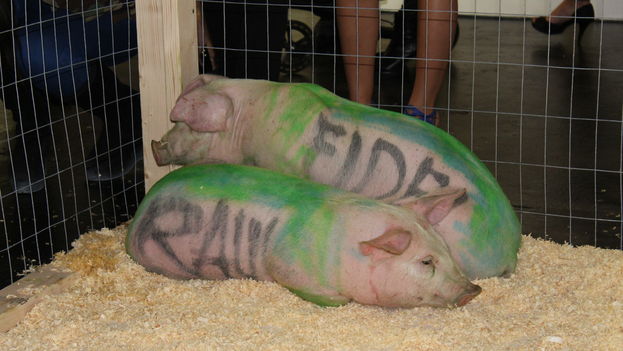
![]() 14ymedio, Mario Penton, Miami, 26 February 2016 – Last night in Miami Danilo Maldonado (known as ‘El Sexto’, The Sixth), was able to show off the pigs Raul and Fidel, which cost him ten months in prison in Cuba. The opening of the exhibition “Pork,” at the Market Gallery in Miami Beach this Thursday, included the performance art piece banned in Cuba at the end of 2014, in which the two pigs walked peacefully around in an area restricted for their display, while a crowd gathered around and flashes lit up the pigs, who now and then appeared to pose.
14ymedio, Mario Penton, Miami, 26 February 2016 – Last night in Miami Danilo Maldonado (known as ‘El Sexto’, The Sixth), was able to show off the pigs Raul and Fidel, which cost him ten months in prison in Cuba. The opening of the exhibition “Pork,” at the Market Gallery in Miami Beach this Thursday, included the performance art piece banned in Cuba at the end of 2014, in which the two pigs walked peacefully around in an area restricted for their display, while a crowd gathered around and flashes lit up the pigs, who now and then appeared to pose.
El Sexto is an artist of freedom. At times irreverent and iconoclastic, but decidedly sensitive and intuitive. “The only way to find freedom is to go out and get it. I am still looking for it, but only this search is what frees you from a state of repression,” he told 14ymedio while preparing for the opening of his first exposition in the United States.
Enlivened by the well-known and controversial band Porno Para Ricardo, the event welcomed hundreds of participants, especially young Cuban Americans, and was a showcase for the work of the artist imprisoned for his performance art piece in Havana’s Central Park, inspired by Orwell, that never saw the light of day until last night in Miami. Since then, the image of the two pigs painted olive-green with the names of Fidel and Raul on their sides, accompany El Sexto wherever he goes.
“For me, the pig chosen by Orwell was the closest thing to the characters I wanted to represent. But in addition, it is the only thing left to us, there is no fish, no chicken… all there is is pork,” he said, to explain his choice.
Maldonado began his artist work painting graffiti on the walls of Havana which he signed underneath with the pseudonym “El Sexto” (The Sixth), as a way of protesting against the huge campaign financed by the Cuban state to demand the release of the five spies considered heroes in Cuba. His social criticism and sarcastic messages were completely unacceptable to the authorities, who interpreted his art as a hostile act.
“I have been a follower of El Sexto for a long time. His work shows the injustice of the Castro regime, the lack of freedom, Valle Grande Prison (where he was held), the hunger strike he was forced to undertake…” commented Sheila Oliva Gonzales, a young Cuban who graduated from the National School of Arts in Cuba and now lives in Miami.
Despite everything, his imprisonment was a learning experience for El Sexto. “In Cuba there is a society that is falling apart, a country that is collapsing and this system has no solutions.”
The trip to the United States has represented a qualitative leap in Maldonado’s artistic career, but also on a personal level. “It helps you to want to transmit what you see to those over here. Here people believe in big dreams, and they are motivated to work, they have a purpose. That makes you fee.”
Ramon Alejandro, one of the great Cuban painters of exile, was present at the exhibition. “I did not know that he was a photographer, or that he painted on fabric, I only knew the drawings that circulated on the internet. He is a very good painter and what he does is very interesting, independent of its social and political implications,” he commented.
Others who were also there were Berta Soler, leader of the Ladies in White, and Antonio Gonzalez Rodiles, director of the Estado de Sats project. “It’s fantastic that he can have the exposition here, because he couldn’t do it in Cuban. It seems that Raul has bought this name and now it is his property, and the name Fidel as well. Now no one can have it, not even the pigs,” lamented Soler.
Danilo Maldonado, who is very close to the Todos Marchamos (We All March) initiative undertaken by several civil society groups on the island and in exile, has said on numerous occasions that his intention is to return to Cuba in March and to continue attending, along with his mother and grandmother, Santa Rita Church, with the Ladies in White. “The importance of Todos Marchamos is that no one has dared to do this before now, to take to the streets,” affirmed the artist.
Former Democratic congressman Joe Garcia, who was also present at the evening, praised Maldonado’s courage, because he had the opportunity to leave Cuba but decided to say. “This makes him a good Cuba, a patriot. The most heroic acts are those silent acts that people undertake to improve their country. And there are thousands and thousands of Cubans who are doing this every day,” he said in praise of El Sexto.
One of the most moving moments of the night, along with the realization of the performance art piece aborted in Havana, was the moment when El Sexto proceeded to get a tattoo of a declaration asking for the freedom of the Venezuelan politician Leopoldo Lopez, imprisoned in that country, and the Cuban political prisoners.
